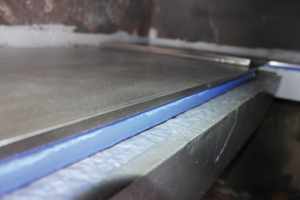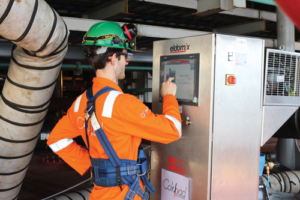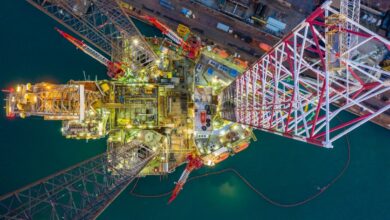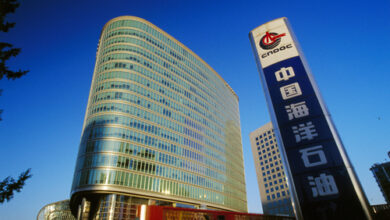Bonded composite reinforcement technology designed to replace hot work, reduce time, costs and hazards during FPSO repairs
Total-backed technology has potential to be used for similar repairs on offshore drilling rigs
By Kelli Ainsworth Robinson, Associate Editor

Many floating production, storage and offloading units (FPSOs) operating today were built as early as the 1970s. As these assets age, they experience corrosion on their hulls and decks, which necessitates in situ repairs as most FPSO do not go to drydock. Typically, hull and deck repairs require hot work, including grinding and welding, which can cause fire and explosion hazards and disrupt production. To address this challenge, French technology company Cold-Pad developed ColdShield in 2016. It uses bonded composite reinforcement for hull and deck repairs on FPSOs, eliminating the need for welding and other hot work. The technology was co-developed with Total and the French Petroleum Institute.
“When you carry out hot works, it is highly probable it will generate operational downtime, while with cold work, you can carry on your operations to generate cash flow while you do the repair,” Christophe Paillusseau, Cold-Pad Vice President of Sales and Marketing, said. “The cost of the repair is, therefore, really linked to the repair itself, with no consequential loss in terms of production.”
Cold-Pad is also exploring drilling applications for the technology, as it can potentially be used for structural repairs on drilling rigs. While ColdShield has already received class approval from the American Bureau of Shipping and Bureau Veritas for FPSO repairs, the company is still seeking class approval for applications on drilling rigs. Mr Paillusseau said that there is certainly a need, with older rigs seeing the same sort of corrosion that older FPSOs are experiencing. “If you take the example of semisubs, in the seawater ballast tanks, repairing or reinforcing either a corroded bulkhead, a side shell or brackets may be challenging,” he said. If these repairs are done with hot work, they would be required to be done in dry dock; this would be difficult in regions like West Africa and would trigger long downtimes. “Being able to do the repair offshore while working lets a drilling contractor better manage the cash flow for their rig,” he said.
The idea for ColdShield was born from the experience of Jean-Phillipe Court, Cold-Pad’s founder and CEO, while he was working offshore Angola as a Structural Engineer for Total. “He realized that hot work was very detrimental for offshore operations because of its associated costs,” Mr Paillusseau explained. In 2011, Mr Court incorporated ColdPad and entered a co-development with Total and the French Petroleum Institute to fund the research and development of ColdShield. Development of the technology took more than three years and €3 million before it was commercialized in 2016 and received class approval certifying a minimum design 10-year life. “ColdShield can now be considered as a true alternative to crop and renew operations.”

The technology can be used to repair and prevent corrosion on the deck, side shell, crude oil tanks and seawater ballast tanks of an FPSO. It consists of a plate made of super duplex alloy over structural polymers, surrounded by an elastomeric seal. ColdShield pads are prefabricated in a workshop and brought to the site for repairs. During installation, the pads are placed over the areas to be repaired. Then, an industrial vacuum is used to reduce the humidity under the area to be sealed off down to as low as 1%. “The bondline will deteriorate more quickly in the presence of humidity,” Mr Paillusseau said. “So we maintain, through our installation process, the bondline in a an environment that is dry.”
Following the dehydration process, structural polymers are injected. The polymers include a resin that bonds to the base metal of the hull, keeping the pad in place for up to 10 years. The installation process was designed for ease of use, Mr Paillusseau said. The process-controlled injection is performed through an automated skid “to remove any human error during the injection,” he added.
With an ageing FPSO fleet, more and more units need extensive work due to corrosion during their planned shutdown periods. By allowing hull structural repairs during production with ColdShield, Mr Paillusseau said, operators can really focus on other critical maintenance operations during planned shutdowns. “Giving them a tool to do the hull structural maintenance outside of planned shutdown gives a lot of extra flexibility to the operator.”
So far, the system has been deployed for an operator offshore West Africa, and another job in the same region is set to take place this summer for a different operator. In the first deployment, ColdShield was used to repair hull brackets inside an FPSO void. The repair campaign took less than a week and did not disrupt production. The operator estimated this resulted in a $3 million saving, Mr Paillusseau noted.
Next, a major operator will use ColdShield for a deck repair campaign on the Girassol FPSO offshore Angola. More than 120 sq m of deck plating will be repaired, including portions of the deck over the crude oil and seawater ballast tanks. The company expects this campaign to take about 50 days. DC





